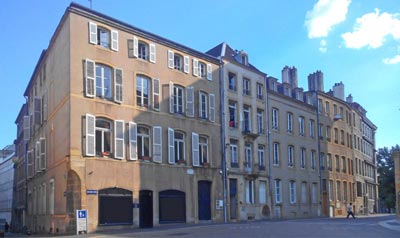LORRAINE’S LITERARY HERITAGE
The literary heritage as a space of identification and appropriation, has proven to be a particularly interesting resource for the territorial and cultural development of the region of Lorraine. Heritage is the designation given to a collection of particular memories that can take different forms from an abstract or a concrete point of view. For the geographer Guy Di Méo the concept integrates “cultural objects, artifacts that have been made or powerfully transformed by human creativity or work, to which will possibly be added esthetic values and symbolic functions”.
DI MEO, Guy, 2008. « Processus de patrimonialisation et construction des territoires ». Colloque “Patrimoine et industrie en Poitou-Charentes : connaître pour valoriser”, Poitiers-Châtellerault, France. Geste éditions, p.87-109.
http://www.ades.cnrs.fr/IMG/pdf/GDM_PP_et_CT_Poitiers.pdf
It is interesting to grasp the forms of the literary resources in the Lorraine region, by doing a first critical review, currently in process, of both the places and the actors of literary tourism (museum managers, associations, etc.) Follow us along the roads of Lorraine parting from this first exploration and around three specific forms (the writer’s house, the museum and literary walks).
LORRAINE’S LITERARY HERITAGE

La maison
Paul Verlaine
(Metz)

“A sort of delicate recognition joins a curiosity worthy to be praised to interest us in the intimate stories of those whose works we admire. The day of their birth, their education, their character (…) everything related to them stops posterity’s attention. We love visiting their dwellings (…).”
Diderot, Essai sur les règnes de Claude et de Néron
A PLACE OF MEMORIES, THE PLACE OF THE AUTHOR’S CONSACRATION
 In 2011, an association of people passionate for the cursed poet opened its doors to the public in the house where Paul Verlan was born (2 rue Haute-Pierre in Metz), a huge middle-class apartment on the second floor, a reconstructed universe to reflect the glory of the man of letters. The visit develops around four exhibition pieces and a reception bookshop. It aims to retrace in a chronological perspective the biographical and poetic itinerary of the author from a collection of objects that are part of many of the writers’ images, like identity markers. One of the objects is consecrated to the poet’s Lorraine origin, to his childhood in Metz, his “fatal cradle” and it sends the public back to “Souvenirs d’un Messin” (1892). In this text, Paul Verlain explains his emotional attachment to the place of his childhood:
In 2011, an association of people passionate for the cursed poet opened its doors to the public in the house where Paul Verlan was born (2 rue Haute-Pierre in Metz), a huge middle-class apartment on the second floor, a reconstructed universe to reflect the glory of the man of letters. The visit develops around four exhibition pieces and a reception bookshop. It aims to retrace in a chronological perspective the biographical and poetic itinerary of the author from a collection of objects that are part of many of the writers’ images, like identity markers. One of the objects is consecrated to the poet’s Lorraine origin, to his childhood in Metz, his “fatal cradle” and it sends the public back to “Souvenirs d’un Messin” (1892). In this text, Paul Verlain explains his emotional attachment to the place of his childhood:
“I am proud more than ever of being Lorrain and Messin, more than the unhappy Lorraine and Metz, and their pain. And, I love Metz and remember somewhat when I was seven and I had to leave her for Paris… these vague snatches of childish recollection are more precious to me, dearer, than the louder and blustering memories…”
Excerpt in response to his long poem “l’Ode à Metz” partly resumed in the Confessions that distill the city’s emblematic places like the Fortress, the Serpenoise Gate or even the Cathedral:
“Metz and its magnificent countryside
Rivers with prolific waves
Wooded hills, fiery vineyards
Cathedrals all in curls
Where the wind sings over the flute
And who answers to it by the Mutte
This great voice of the Good God.”
It is worth pointing out that the lovers of the “prince of poets” may consult two manuscript versions of this collection in the Verlaine media library in the city, thanks to an international reference fund rich with numerous original editions and including a great variety of documents (autographs and manuscripts, published texts, translations, images, music).
The association “les amis de Verlaine” claims the need to preserve by this place, the literary patrimony in order to bring back “the spirit of an author, give charm and life to a space full of history, bring memories to life through writing and through an invitation to a journey…”. This writer’s house has become a place of worship that aims to offer the curious, the scholars and all types of visitors an opportunity to know the work of Paul Verlaine. This desire for turning into the heritage of literature by using a specific place is consistent with the guidelines of the Federation of Writers´ Homes and Literary Heritage (http://www.litterature-lieux.com), It was created in France in 1997, with the purpose of connecting the different places and literary heritages (monuments, collections, archives, documents), while assuring the existence, preservation and cultural influence of the writers’ houses. This group contributes wholeheartedly to the sacralisation of the authors, “the search of the lost aura” according to the ethnologist Daniel Fabre. (http://www.litteraturelieux.com/multimedia/File/publications/fabre.pdf)

A PLACE OF MEDITATION
Paul Verlaine’s home not only represents one of the means of exposing literature apart from the texts, but it is also recognized as a place of cultural mediation around the author´s figure. In fact, a wide variety of literary activities are offered to the public in different forms: poetic readings of the text by different voices recalling the life of the poet, recitals, poetic cabarets, exhibitions from artists connected to the author, poetry contests, an annual tribute to Verlaine in front of the monuments dedicated in his honor in Metz (on the Esplanade) and in Paris (Jardin du Luxembourg).
